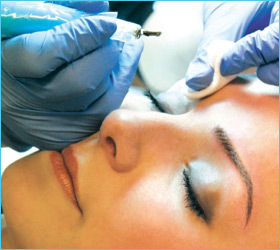With training from around the world, we guarantee to provide the most innovative permanent makeup, paramedical, and men’s micro pigmentation enhancing procedures. Conveniently located off of I-285 in North Atlanta, we are easily accessible to all of our clients and newcomers throughout the southeast. Keeping your schedule in mind, we are flexible enough to accommodate even the most hectic lifestyles.

What is Permanent makeup?
Permanent makeup, or cosmetics is a modern day, state-of-the -art form of tattooing used to enhance features. Colored pigments are implanted into the Dermis (middle layer) of the skin through microscopic injections with an extremely fine needle or cluster of needles. This process is also called “Micropigmentation”, “Microdermal Pigmentation”, “Dermagraphics”, “Intradermal Cosmetics”, “Dermal Implantation”, or “Micropigment Implantation”. Permanent Makeup is the term used to describe the cosmetic tattooing of facial features (eyebrows, eyelids, or lips) to improve color and shape.
What is Paramedical Permanent Cosmetics?
A highly specialized and advanced area of permanent cosmetics which focuses on people with medically-related conditions.
Examples:
- surgical scars (e.g. facelift, breast augmentation/reconstruction, hair transplant)
- trauma scars (e.g. accidents or burns)
- unnatural skin conditions (e.g. Vitiligo, Alopecia)
The techniques restore color and symmetry to an affected area(s). The results can help a person look better plus improve his or her self esteem. This process is also called “Medical Tattooing”, “Paramedical Tattooing”, “Corrective Tattooing”, “Reconstructive Tattooing”, or “Restorative Tattooing”.
Are Permanent Cosmetics safe?
According to the Centers for Disease Control (CDC), permanent cosmetics are safe when the technician is educated in the control of Blood Borne Pathogens and follows all OSHA (Occupational Safety and Health Administration) guidelines. However, permanent cosmetics are not licensed or regulated in most states including Georgia. We use only Digital Nouveau contour machines which are CDC certified.
Is a Cosmetic Tattooing procedure painful?
Due to the invasiveness of the process, some may feel minor discomfort. This varies according to each person’s pain threshold and response to anesthetics. People describe what they feel in different ways such as “irritation”, “scratching”, “vibration”, or “a slight burning sensation.” Those with body art (traditional tattoos are done without anesthetics and go much deeper into the dermis using more rudimentary equipment with much heavier vibration) comment that cosmetic tattooing is painless compared to traditional tattooing. Overall, people feel the benefits from the results far outweigh any brief discomfort they might have experienced during the process.
What will the final color look like?
Permanent makeup colors should be selected to compliment a person’s skin tone, hair, and eye color. We take a conservative approach because it is easier to make an existing color darker versus lighter. Colors will always look darker and more intense immediately after the procedure, then gradually lighten and soften upon healing. For medical tattooing (e.g. scar camouflage or areola re-pigmentation), color spot testing is utilized to determine the best custom combination of colors for the tattooed area. We will recorded the pigment(s) used for a client in her/his file for reference.
Why is the color so dark right after the procedure?
Wet pigment looks much darker than when it is dry, much the same as clothing when it’s removed from a washer. The same principle applies to permanent cosmetics. Pigments contain dry microscopic powder particles suspended in a clear liquid. When the body absorbs the liquid, the colored particles remain where they were implanted and gradually return to or “dry to” their original powder color. Also, the skin underneath the tattoo turns red and “flushed” from blood flow during the process. This background redness contributes to the darker appearance but once the redness subsides, the color will appear significantly lighter.
How long do Permanent Cosmetics last?
The procedures are considered “permanent” because the tattooed color cannot be washed off, however, the color should really be considered “semi-permanent” because fading will occur over time. Color retention is affected by various factors: the shade of the original color, the person’s age/metabolism, skin type and condition, exposure to UV radiation (sun, tanning booths), smoking, certain drugs and medications, and skin peeling treatments such as Retin-A or microdermabrasion. Results generally the color lasts from one to five years and can be enhanced and refreshed by a maintenance visit yearly which will be at a reduced rate when kept maintained.
What is a Touch-up appointment?
During the initial procedure the tattooed area(s) will be saturated with as much color as possible. Due to swelling, there may be some areas where the tissue will no longer allow pigment to be implanted which will show less color after healing and may need another visit to be filled-in (a touch-up). Because everyone’s tissue reaction will vary, some clients will need a second visit and others will not. The area must heal before a refinement procedure can be performed. It is best to wait 4 to 8 weeks for complete tissue healing and color stabilization. Once the desired results are achieved, the client can keep the color looking fresh with a maintenance visit every few years.
What is the recovery period like?
Immediately following the procedure, expect mild swelling, redness, and some tenderness that can last from a few hours to a few days. Eyebrows heal most quickly and swell less than eyelids and lips. With lip procedures there may also be slight bruising. The color looks much darker immediately afterward for any procedure. It will lighten significantly for 3 to 7 days and will continue to lighten over several weeks. Ointment is used during the first week and must be applied to the tattooed area for protection as well as to minimize scabbing. Many people are amazed at how “normal” they look right after their treatment and most do not feel it is necessary to take time off from work.
How long does each procedure take?
Expect an average of 2 hours or more for an initial appointment if it includes a consultation and a review of your medical history. We will determine the best design, select color, numb the area, then do the actual procedure. After photos and after care instructions will follow. You will be able to have any questions answered before leaving with your new enhancement. Follow-up visits usually require less time. With scar camouflage work, spot testing for color accuracy must be completed 6 weeks before the actual tattooing procedure.
Will Permanent Makeup continue to look good as I age?
It is true that as we age, our skin and its elasticity changes. Just as there are many older women who look great wearing traditional makeup as long as it is correctly applied. These women would look just as great- or even better- with skillfully applied permanent makeup. If planning to have extreme lifting of an area let us know so that we may plan ahead. For example, if a brow lift is performed after a permanent eyebrow procedure, the eyebrows could be raised and look different. Good communication is the best way to insure a fantastic result.
Is a Cosmetic Tattooing procedure expensive?
Permanent cosmetics are affordable for most people and considering the long term benefits, quite inexpensive. Other non-surgical procedures like Botox or dermal fillers cost the same or more but may last for only three to twelve months. The savings from not having to buy makeup products that are applied daily adds up rapidly. Convenience and time gained by not applying makeup: certainly valuable. What is your time worth? Self-esteem restored by medical tattooing: priceless! In Atlanta, the fee for permanent eyebrows can range from $150 to $1,500 for one to two applications. The “average” price is about $400 to $600 for two applications. You can only make an informed decision on price when comparing technicians with the same artistic abilities.

